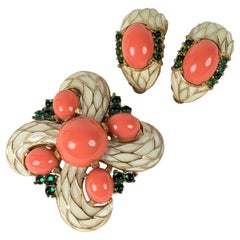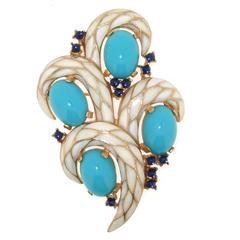Trifari Orient Brooch
Vintage 1960s American Brooches
Gilt Metal
Recent Sales
Late 20th Century American Brooches
Base Metal, Gold Plate
People Also Browsed
Vintage 1980s Chain Necklaces
Vintage 1980s Brooches
1930s Unknown Evening Gowns
Vintage 1980s Brooches
21st Century and Contemporary Italian Link Bracelets
18k Gold, Yellow Gold
Vintage 1980s Link Bracelets
Vintage 1930s French Art Deco Pendant Necklaces
Pearl, Gold
1980s French Maxi Dress
Mid-20th Century Retro Brooches
Crystal, Gold Plate
Vintage 1970s American Modernist Cocktail Rings
Gold, 18k Gold, Yellow Gold, Enamel
1980s American Evening Gowns
Vintage 1930s American Art Deco Brooches
Crystal, Rhodium, Base Metal, Gilt Metal
Late 20th Century American Modern Cocktail Rings
18k Gold, Yellow Gold, Enamel
21st Century and Contemporary American Contemporary Beaded Necklaces
Diamond, Emerald, Platinum
Late 20th Century American Modern Cocktail Rings
Gold, 14k Gold, Yellow Gold, Enamel
20th Century French Artisan Drop Necklaces
Diamond, Ruby, Platinum
Trifari for sale on 1stDibs
Costume jewelry maker Trifari is widely loved for its fine craftsmanship and complex designs for necklaces, brooches and other jewelry and accessories.
The company was formed in New York during the early 1920s, when its partners Gustavo Trifari (who descended from a family of jewelers), Leo Krussman and Carl Fishel (business associates in hair-ornament manufacturing) recognized, as other designers during the Art Deco era such as Gabrielle “Coco” Chanel had, that fashion trends for affordable jewelry for everyday wear represented an opportunity (and that the popularity of shorter hairstyles didn’t bode well for their haircomb business).
Initially called Trifari, Krussman and Fishel Jewelry (T.K.F.), the trio eventually shortened their brand’s name, at the suggestion of an advertising professional, to Trifari in order to evoke the romance of Gustavo’s native Italy.
The hiring of French designer Alfred Philippe as head designer in 1930 was pivotal to Trifari’s success. A master craftsman who had worked with both Cartier and Van Cleef & Arpels, Philippe set about establishing the same high-quality standards of materials and craftsmanship in the design of fashion jewelry and trained other Trifari artisans to do the same. Settings were delicate; crystals were hand set; designs, which sometimes featured dazzling floral motifs or exquisite depictions of marine life, were sophisticated and elegant, having both the look and feel of fine jewelry. First Lady Mamie Eisenhower wore a Trifari parure of faux pearls to her husband’s presidential inauguration in 1953 and Trifari glass pearls to his inaugural ball in 1957.
Before retiring in 1968, Philippe created Trifari’s most recognizable designs. In the 1930s, when the company was custom-making accessories for the stars of Broadway musicals, it was the crown motif: These brooches became so often identified with the brand that a crown was eventually incorporated into the trademark. In the 1940s, the “Jelly Bellies” inspired affection as well as knockoffs; these were animals, birds and insects sporting a “belly” of clear Lucite. Clip-Mates were another favorite and a technical marvel — two dress clips that, joined together, created a brooch.
Find a wide range of vintage Trifari jewelry on 1stDibs.
Finding the Right Brooches for You
Vintage brooches, which refer to decorative jewelry traditionally pinned to garments and used to fasten pieces of clothing together where needed, have seen increasing popularity in recent years.
While jewelry trends come and go, brooches are indeed back on the radar thanks to fashion houses like Gucci, Versace, Dior and Saint Laurent, all of which feature fun pinnable designs in their current collections. Whether a dazzlingly naturalistic Art Nouveau dragonfly, a whimsical David Webb animal, a gem-studded bloom or a streamlined abstract design, these jewels add color and sparkle to your look and a spring to your step.
Given their long history, brooches have expectedly taken on a variety of different shapes and forms over time, with jewelers turning to assorted methods of ornamentation for these accessories, including enameling and the integration of pearls and gemstones. Cameo brooches that originated during the Victorian age are characterized by a shell carved in raised relief that feature portraits of a woman’s profile, while 19th-century micromosaic brooches, comprising innumerable individually placed glass fragments, sometimes feature miniature depictions of a pastoral scene in daily Roman life.
At one time, brooches were symbols of wealth, made primarily from the finest metals and showcasing exquisite precious gemstones. Today, these jewels are inclusive and universal, and you don’t have to travel very far to find an admirer of brooches. They can be richly geometric in form, such as the ornate diamond pins dating from the Art Deco era, or designer-specific, such as the celebrated naturalistic works created by Tiffany & Co., the milk glass and gold confections crafted by Trifari or handmade vintage Chanel brooches of silk or laminated sheer fabric. Chanel, of course, has never abandoned this style, producing gorgeously baroque CC examples since the 1980s.
Brooches are versatile and adaptable. These decorative accessories can be worn in your hair, on hats, scarves and on the lower point of V-neck clothing. Pin a dazzling brooch to the lapel of your blazer-and-tee combo or add a cluster of smaller pins to your overcoat. And while brooches have their place in “mourning jewelry,” in that a mourning brooch is representative of your connection to a lost loved one, they’re widely seen as romantic and symbolic of love, so much so that a hardcore brooch enthusiast might advocate for brooches to be worn over the heart.
Today, find a wide variety of antique and vintage brooches for sale on 1stDibs, including gold brooches, sapphire brooches and more.

